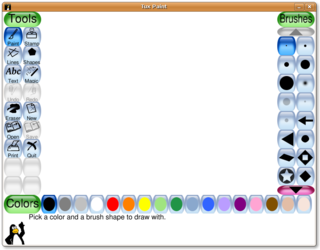
Adobe Flash is, except in China, a discontinued multimedia software platform used for production of animations, rich internet applications, desktop applications, mobile apps, mobile games, and embedded web browser video players.
An application program is a computer program designed to carry out a specific task other than one relating to the operation of the computer itself, typically to be used by end-users. Word processors, media players, and accounting software are examples. The collective noun "application software" refers to all applications collectively. The other principal classifications of software are system software, relating to the operation of the computer, and utility software ("utilities").

Tux Paint is a free and open source raster graphics editor geared towards young children. The project was started in 2002 by Bill Kendrick who continues to maintain and improve it, with help from numerous volunteers. Tux Paint is seen by many as a free software alternative to Kid Pix, a similar proprietary educational software product.

Krita is a free and open-source raster graphics editor designed primarily for digital art and 2D animation. Originally created for Linux, the software also runs on Windows, macOS, Haiku, Android, and ChromeOS, and features an OpenGL-accelerated canvas, colour management support, an advanced brush engine, non-destructive layers and masks, group-based layer management, vector artwork support, and switchable customisation profiles.
A number of vector graphics editors exist for various platforms. Potential users of these editors will make a comparison of vector graphics editors based on factors such as the availability for the user's platform, the software license, the feature set, the merits of the user interface (UI) and the focus of the program. Some programs are more suitable for artistic work while others are better for technical drawings. Another important factor is the application's support of various vector and bitmap image formats for import and export.
SketchUp is a 3D modeling software that allows users to create and manipulate 3D models of buildings, landscapes, furniture, and other objects. It is commonly used in architecture and interior design.

Synfig Studio is a free and open-source vector-based 2D animation software. It is created by Robert Quattlebaum with additional contributions by Adrian Bentley.

DrawPlus is a 2D vector graphics editor and animation software developed by the UK-based software company Serif, also responsible for PhotoPlus, PagePlus, WebPlus, Digital Scrapbook Artist, Affinity Designer, Affinity Photo and other titles.

3D computer graphics, sometimes called CGI, 3-D-CGI or three-dimensional computer graphics, are graphics that use a three-dimensional representation of geometric data that is stored in the computer for the purposes of performing calculations and rendering digital images, usually 2D images but sometimes 3D images. The resulting images may be stored for viewing later or displayed in real time.

Toon Boom Animation Inc., also known as Toon Boom, is a Canadian software company founded in 1994 and based in Montreal, Quebec. It specializes in the development and production of animation and storyboarding software for film, television, the World Wide Web, video games, mobile devices, training and education.
Cocos2d is an open-source game development framework for creating 2D games and other graphical software for iOS, Android, Windows, macOS, Linux, HarmonyOS, OpenHarmony and web platforms. It is written in C++ and provides bindings for various programming languages, including C++, C#, Lua, and JavaScript. The framework offers a wide range of features, including physics, particle systems, skeletal animations, tile maps, and others.

In 3D computer graphics, 3D modeling is the process of developing a mathematical coordinate-based representation of a surface of an object in three dimensions via specialized software by manipulating edges, vertices, and polygons in a simulated 3D space.
Fatpaint is a free, online (web-based) graphic design and desktop publishing software product and image editor. It includes integrated tools for creating page layout, painting, coloring and editing pictures and photos, drawing vector images, using dingbat vector clipart, writing rich text, creating ray traced 3D text logos and displaying graphics on products from Zazzle that can be purchased or sold. Fatpaint integrates desktop publishing features with brush painting, vector drawing and custom printed products in a single Flash application. It supports the use of a pressure-sensitive pen tablet and allows the user to add images by searching Wikimedia, Picasa, Flickr, Google, Yahoo, Bing, and Fatpaint's own collection of public domain images. The completed project can be saved on Fatpaint's server or locally. Fatpaint is affiliated with Zazzle, and owned by Mersica.
Ajax Animator is a free, web-based animation suite. Its development began in March 2006 by Antimatter15, then a sixth grader. Ajax Animator was originally intended to be a free replacement to Flash MX, but is now a general-purpose animation tool. Ajax Animator is primarily written using JavaScript, the Ext JS framework, and HTML5-related technologies such as SVG. The software can be used either from within a web browser or from an offline installation.
Reallusion is a 2D and 3D character creation and animation software developer with tools from cartoon characters to digital humans and animation pipelines for films, real-time engines, video games, virtual production, archvis.
CrazyTalk is Reallusion's brand name for its 2D animation software. The product series includes CrazyTalk, a 2D facial animation software tool, and CrazyTalk Animator, a face and body 2D animation suite.

Sketch is a vector graphics editor for macOS developed by the Dutch company Sketch B.V.. It was first released on 7 September 2010 and won an Apple Design Award in 2012. It also has a web application that allows users to share files online.








